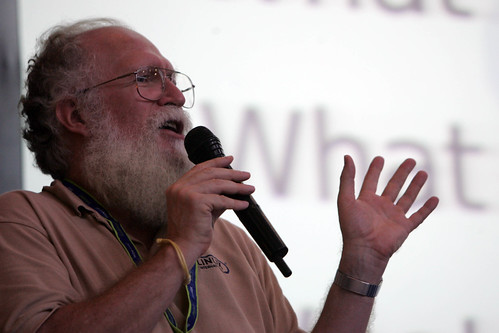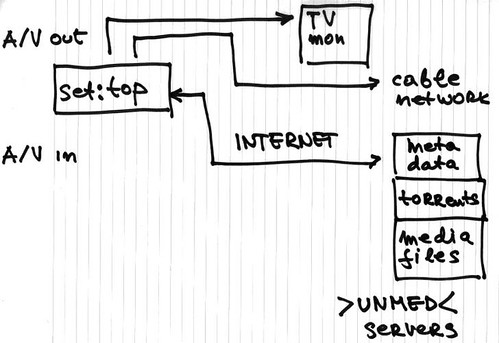Steve Jobs, Apple CEO, yesterday got into the DRM debate with a insightful post on the matter. Since many players have been asking Apple to open up its DRM system from some time now, and considering that citizens and associations are starting to reject DRM, Steve Jobs decided to examine the current situation suggestingt three possible alternatives for the future.
While iPods can play music DRM-free, iTunes sells music enveloped in a DRM mechanism, making impossible to play it on other devices, locking users into Apple’s ecosystem.
The first alternative is to continue on the current course, with each manufacturer competing freely with their own “top to bottom†proprietary systems for selling, playing and protecting music. [..]
Some have argued that once a consumer purchases a body of music from one of the proprietary music stores, they are forever locked into only using music players from that one company. Or, if they buy a specific player, they are locked into buying music only from that company’s music store. Is this true? Let’s look at the data for iPods and the iTunes store – they are the industry’s most popular products and we have accurate data for them. Through the end of 2006, customers purchased a total of 90 million iPods and 2 billion songs from the iTunes store. On average, that’s 22 songs purchased from the iTunes store for each iPod ever sold.
Today’s most popular iPod holds 1000 songs, and research tells us that the average iPod is nearly full. This means that only 22 out of 1000 songs, or under 3% of the music on the average iPod, is purchased from the iTunes store and protected with a DRM. The remaining 97% of the music is unprotected and playable on any player that can play the open formats. Its hard to believe that just 3% of the music on the average iPod is enough to lock users into buying only iPods in the future. And since 97% of the music on the average iPod was not purchased from the iTunes store, iPod users are clearly not locked into the iTunes store to acquire their music.
Here Steve Jobs is strechting the truth. I believe that “only” 22 songs on average are bought by iTunes, but I think that an iTunes’s customer is buying more than 22 songs, and I can hardly believe he is buying them somewhere else. Last but not least I can’t believe that every iPod is containing 1000 songs, while I know that it can’t hold more of them.
The second alternative is for Apple to license its FairPlay DRM technology to current and future competitors with the goal of achieving interoperability between different company’s players and music stores. On the surface, this seems like a good idea since it might offer customers increased choice now and in the future. And Apple might benefit by charging a small licensing fee for its FairPlay DRM. However, when we look a bit deeper, problems begin to emerge. The most serious problem is that licensing a DRM involves disclosing some of its secrets to many people in many companies, and history tells us that inevitably these secrets will leak. The Internet has made such leaks far more damaging, since a single leak can be spread worldwide in less than a minute. [..]
Apple has concluded that if it licenses FairPlay to others, it can no longer guarantee to protect the music it licenses from the big four music companies.
I see his point, it makes perfect sense: no way to build gates in front of the sea.
The third alternative is to abolish DRMs entirely. Imagine a world where every online store sells DRM-free music encoded in open licensable formats. In such a world, any player can play music purchased from any store, and any store can sell music which is playable on all players. This is clearly the best alternative for consumers, and Apple would embrace it in a heartbeat.[..]
Why would the big four music companies agree to let Apple and others distribute their music without using DRM systems to protect it? The simplest answer is because DRMs haven’t worked, and may never work, to halt music piracy. [..]
In 2006, under 2 billion DRM-protected songs were sold worldwide by online stores, while over 20 billion songs were sold completely DRM-free and unprotected on CDs by the music companies themselves. The music companies sell the vast majority of their music DRM-free, and show no signs of changing this behavior, since the overwhelming majority of their revenues depend on selling CDs which must play in CD players that support no DRM system.[..]
Much of the concern over DRM systems has arisen in European countries. Perhaps those unhappy with the current situation should redirect their energies towards persuading the music companies to sell their music DRM-free. For Europeans, two and a half of the big four music companies are located right in their backyard. The largest, Universal, is 100% owned by Vivendi, a French company. EMI is a British company, and Sony BMG is 50% owned by Bertelsmann, a German company. Convincing them to license their music to Apple and others DRM-free will create a truly interoperable music marketplace. Apple will embrace this wholeheartedly.
I’m with you Steve, help us to do it!
Read the full story.
 Jon Hall Maddog by Pizel y Dixel
Jon Hall Maddog by Pizel y Dixel

 Save the forest by
Save the forest by  Blueprint by
Blueprint by  Schoolroom by
Schoolroom by  set Top box Diagram by
set Top box Diagram by 
Reply